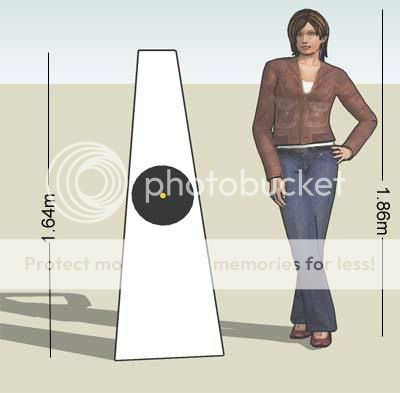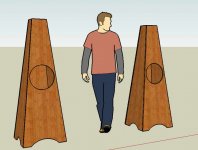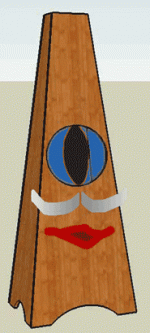Nordic said:How do I work out the lenght of the feet part that extends past the bottom...? those bits with the curves cut out...
They aren't even necessary if you run the port out the front, back or sides...
dave
Nordic said:
About the AN-12's, I see the cast frame does not go so low... what is gained in exchange for it giving up the few Herz before the smaller models and non-cast 12"?
Hi Nordic,
This is what Commonsense tells me:
"Subjectively, the Cast 10 and 12 have more extension, a more 'open' midrange, and better control and precision."
"The Cast Frame 10 and 12 were a total redesign. Frankly, I was expecting about the same 10% improvement that we got with the Cast 8 over the Super 8. But, if I were to quantify it, I would probably estimate the improvement as more like 25 to 30%."
jerry
Thanks...
the numbers on their site makes the smaller drivers seem more appealing, I knew there had to be more to it, to even make this a viable seller...
The Audio Nirvana 'Super 12 Cast Frame' has a frequency response from 36 hz to almost 20,000 hz.
The Audio Nirvana 'Super 12' has a frequency response from 33 hz to almost 20,000 hz.
The Audio Nirvana 'Super 10 Cast Frame' has a frequency response from 34 hz to almost 20,000 hz.
The Audio Nirvana 'Super 10' has a frequency response from 36 hz to almost 20,000 hz.
P.S. Will someone please tell this guy that it is Hz not hz....
These come close to my current two ways as far as FS is concerned, going from low 30's to where ever a 70's japanese silkdome tweeter goes to.
the numbers on their site makes the smaller drivers seem more appealing, I knew there had to be more to it, to even make this a viable seller...
The Audio Nirvana 'Super 12 Cast Frame' has a frequency response from 36 hz to almost 20,000 hz.
The Audio Nirvana 'Super 12' has a frequency response from 33 hz to almost 20,000 hz.
The Audio Nirvana 'Super 10 Cast Frame' has a frequency response from 34 hz to almost 20,000 hz.
The Audio Nirvana 'Super 10' has a frequency response from 36 hz to almost 20,000 hz.
P.S. Will someone please tell this guy that it is Hz not hz....
These come close to my current two ways as far as FS is concerned, going from low 30's to where ever a 70's japanese silkdome tweeter goes to.
What level of fudge factor is there with the actual dimensions?
I.e. will a few mm diffirence to the top plate make a big diffirence?
Just trying to make something that can actualy be dialed in on a saw, like 83 degrees as opposed to 83.34.
I guess one could also alter the height by a few mm
Edit:
Scrap that idea... seems it makes a huge diffirence in dimensions.
Angle = 83.34
Hypotenuse Side =1534.7825
Opposite Side=1524.4256
Changeing the angle to 83, would reduce height to 1449.6937 from 1524.4256 i.e. 3 inches
I.e. will a few mm diffirence to the top plate make a big diffirence?
Just trying to make something that can actualy be dialed in on a saw, like 83 degrees as opposed to 83.34.
I guess one could also alter the height by a few mm
Edit:
Scrap that idea... seems it makes a huge diffirence in dimensions.
Angle = 83.34
Hypotenuse Side =1534.7825
Opposite Side=1524.4256
Changeing the angle to 83, would reduce height to 1449.6937 from 1524.4256 i.e. 3 inches
Have you considered posting these pretty specific questions on The Metronome thread?
It sounds like a great project to contribute to the Metronome family.
Jerry
It sounds like a great project to contribute to the Metronome family.
Jerry
Oh, of course. I just know all the various builders of the Metronome are there, that's all.
The Metro box for the Super 12 was big for me. So I had been looking at the Metronome as a serious option for the Cast 10. It's curve is also amazing. Now that the dimensions for the Cast 12 are out and smaller it is, to my mind, a killer combination if someone would like the option of not using a sub.
Go for it! The looks are outstanding for a 12in too. Very harmonious.
Jerry
The Metro box for the Super 12 was big for me. So I had been looking at the Metronome as a serious option for the Cast 10. It's curve is also amazing. Now that the dimensions for the Cast 12 are out and smaller it is, to my mind, a killer combination if someone would like the option of not using a sub.
Go for it! The looks are outstanding for a 12in too. Very harmonious.
Jerry
VanJerry said:
Thank you GM,
....I grappled with the fact that I might underestimate the room gain for my small 11x15 basement room.
In my case what I know has never included a bump.
And I will have 3 x 12in drivers in the small room, with another 2 x 8in.......
The other aspect that appeals to my inexperienced self is that the 3.5 ft^2 aperiodic damped vent BR provides some flexibility to go lower.
You're welcome!
Since higher SQ comes from attenuating too much acoustic gain Vs boosting too little, best to always underestimate the acoustic gain BW needs if you don't have an acoustic map of the room to design ALL your speakers to best blend.
As for the 'bump', all else being equal it's the byproduct of a shorter tuning length, so if it's too much, just bleed it off as required by either gapping the driver away from the baffle or a bleed hole in the top rear.
As for your 'small' room, it's bigger than the one I'm typing in, though down low, a basement will typically yield more gain for a given BW below where the room gets 'on the pipe' so-to-speak, i.e. ~565 ft/longest dim = 36.67 Hz in your case. Above this point there will be boundary gain of course, so how close to a boundary or corner will decide how much of the speaker's roll off BW gets boosted at what gain curve.
Obviously, putting form fitting triangular cabs in the corners yields the most and if along a wall the cab needs to be as flat as practical for best results, so your need for narrow baffles pretty much dictates they be well away from any boundaries for best blend which in turn dictates a sub system if you can't get them ~maximally flat at the listening position down to ~36.67 Hz.
Hmm, at least WRT the mains in a HT app (and in theory each surround channel), each channel has to be designed in isolation due to how the signals are encoded/decoded, so driver requirements are based on SPL and directivity, ergo your driver complement may be anywhere from overkill to woefully inadequate. Since you've yet to put any numbers on your alleged lower than average listening levels there's no way to know where your proposed selections slot in.
Yeah, the stuffed BR does allow for more tuning flexibility as long as you keep the vent reasonably small/short as a baseline, though you can add a vent at the bottom of a TQWT, so a moot point IMO. The BR is potentially a slightly easier build from a panel angle cutting POV though depending on several variables.
Another factor you apparently haven't considered is how we perceive loudness WRT comfortable average/peak levels. The old C-V marketing mantra I use for a signature tells it all 'in a nutshell': Loud is Beautiful if it's Clean! in that the lower in distortion a system is, the louder we tend to listen at, so while a ~62 dB/listening position average is a plenty loud enough SPL sitting here listening to music or a movie through a POS soundcard coupled to a similar SQ computer sub/sat system is at least 85 dB when in the living room through a vanishing low distortion system to get a similar perceived performance, albeit a wider LF gain BW one.
This latter point is very important when considering lower average SPLs in that due to our acute hearing gain curve we must boost the LF, treble BW (AKA 'loudness' control) to compensate, so each channel's low distortion gain BW becomes increasingly important, increasing the potential need for a sub and treble system, not reduce it.
Bottom line, it's always best to design/build the most efficient system practical for your various $$$/size/whatever 'budgets' and if you don't need it all, it just means you get to enjoy an even lower distortion system than predicted, firm in the knowledge that if you ever get a 'wild hair' or just want to impress, you can. I mean how often in the USA (and increasingly around the world) can a Ferrari or similar car owner take advantage of even a sizable fraction of its performance potential other than on a closed course racetrack?
GM
In my case what I know has never included a bump.
Chasing a perfectly flat frequency response curve is pretty pointless. Sometimes good enough is good enough.
Not sure if you realize this, but the acoustics of ANY room are going to chop up your pretty graph anyway as soon as the speaker is used in an actual physical room. You are worried about a tiny bump, but when placed in room, the reponse at listening position could have +/- 20 db peaks and dips.
For example, take a picture of your perfect response curve and let a 3 year old draw on it a bit. Then it will look a bit more like in room response.
Kofi Annan said:Yes. These are nice and big. They will be mine.
Attachments
Funny how after 372 posts and MUCHO bullsh**, we've finally come around to what I've been trying to say from the beginning.
I recommended to build the biggest , most efficient sealed system that VanJerry could tolerate. It would provide the best transient respone, the best quality sound, and the easiest build.
Gee, I guess there is something to K.I.S.S.
VanJerry, my recommendation is that you stop looking at the CPU , as this will just delay your "Nirvana" .
Just Build it already . . . . .
.......................................Blake
I recommended to build the biggest , most efficient sealed system that VanJerry could tolerate. It would provide the best transient respone, the best quality sound, and the easiest build.
Gee, I guess there is something to K.I.S.S.

VanJerry, my recommendation is that you stop looking at the CPU , as this will just delay your "Nirvana" .
Just Build it already . . . . .
.......................................Blake
Nihilist said:
VanJerry, my recommendation is that you stop looking at the CPU , as this will just delay your "Nirvana" .
I ordered 3xCast 12's and 2xCast 8's today.
But what is "CPU"?
just a guy said:
Chasing a perfectly flat frequency response curve is pretty pointless. Sometimes good enough is good enough.
Practically speaking, I have to agree. To be honest, I've been caught grabbing at bumps
In fact, by careful design of bracing I can include the option of inserting a slanting divider and using the same box to try a smaller tapered TL similar to GM's. (I would use only screws and removable seals in this case.) I can even use the 3.5ft^3 to try Nihilist's true sealed.
I can compare all these. And learn.
Jerry
"I ordered 3xCast 12's and 2xCast 8's today.
But what is "CPU"?"
Good for you ! ! ! ! Happy building !
CPU is "central processing unit" , or short/slang for computer.
I like your idea of the transformable cabinet. Should provide some insight.
................................Blake
But what is "CPU"?"
Good for you ! ! ! ! Happy building !
CPU is "central processing unit" , or short/slang for computer.
I like your idea of the transformable cabinet. Should provide some insight.
................................Blake
- Status
- This old topic is closed. If you want to reopen this topic, contact a moderator using the "Report Post" button.
- Home
- Loudspeakers
- Full Range
- Low level body/weight presence wanted: Can 12" full range deliver?


